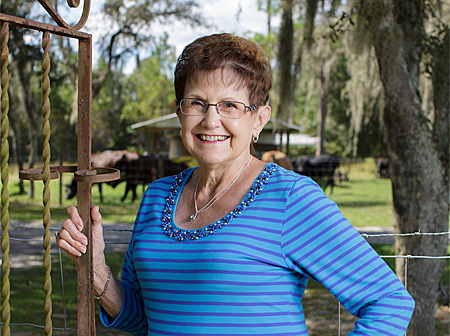Successful spine surgery has patient living pain free

Sharon Meeks has spent her life taking care of her family. She and her husband were married for 55 years. They raised three children and worked hard on their 107-acre cattle farm in central Florida. Hearing Sharon’s story, you might never guess that she was plagued with adult scoliosis for more than a decade.
Sharon had surgery many years ago to treat a routine spinal problem. The surgery was successful, but over time, her condition continued to worsen. Her posture curved. She was involuntarily leaning to one side and arching forward. This shift in stance was causing her terrible hip and back pain. She couldn’t walk. She could barely stand long enough to do normal activities like prepare a meal. The progressive deformation of her spine was debilitating. Her primary physician told her that if she didn’t do something to correct this problem, she would be confined to a wheelchair within 12 months.
So, Sharon, now 75 years old, did something.
Her son, Sanford, had studied at the University of Florida College of Medicine and worked with several faculty members in the department of neurosurgery. He knew his mom needed a level of care that might not be available in their local community. So, he encouraged his mother to see Daniel J. Hoh, M.D., a UF Health neurosurgeon and assistant professor in the department of neurosurgery, to determine if there was a potential cure for her complex spinal condition.
Dr. Hoh is experienced in complex spinal procedures, including scoliosis surgery, and has performed more than 1,000 spinal operations in his time at UF Health. He evaluated Sharon, identified that she had adult onset scoliosis and determined she was an ideal candidate for scoliosis correction surgery. After several in-person meetings with Dr. Hoh and with the support of her family, Sharon decided to proceed with an operation.
Sharon’s all-day surgery involved several intricate steps. Dr. Hoh had to remove the spinal instrumentation from her prior surgery. Then, he performed multiple osteotomies – procedures that involve carefully placed wedge cuts in the vertebra to increase the flexibility of the spine. Once the spine was correctable, he was able to directly manipulate the spinal column to restore it back to normal alignment, thereby reversing the underlying scoliosis. Finally, the operation involved inserting new spinal instrumentation across multiple levels to stabilize the newly re-aligned spine.
“I heard there were more than 25 people in the waiting room praying for me,” Sharon said. “I had so much support from friends, people from church and my family.”
Dr. Hoh said in the past, people like Sharon might not have been considered good candidates for this kind of surgery.
“Traditionally, surgeons may have considered cases like Sharon’s inoperable because either the spinal deformity was too complicated, or they considered the patient’s age to be too high of a risk for surgery,” Dr. Hoh said. “But now, with advances in current medicine, we have better surgical techniques, spinal implant technology, anesthesia, critical care, therapy and rehabilitation – all of which open the possibility of potentially life-improving surgery for people who previously were without hope.”
According to Dr. Hoh, many patients who were once told that they suffered from “failed back syndrome” and that no corrective options existed, may in fact have treatable underlying adult scoliosis. With better recognition of this increasing age-related problem, both conservative and surgical treatment options may be available for some of these individuals.
“I didn’t want to be in a wheelchair. I wanted to be up doing things with my children and my friends,” Sharon said.
Dr. Hoh said recent research has shown that in carefully selected patients, adult scoliosis correction surgery can significantly improve pain and quality of life. More importantly, surgeons are learning how to use advanced preoperative imaging to individually tailor the surgical technique and achieve the optimal spinal alignment and best, postoperative result for each patient.
After surgery, Sharon worked diligently through physical and occupational therapy. She is happily back to living an active life on her farm. She is busy with her church group, and she’s able to shop for hours with her daughter – all of the activities that she loved doing, and was unable to do before the surgery.
“It’s like a miracle,” she said. “I can walk. That’s the biggest result from the surgery. I can walk, and I have no pain.”
Dr. Hoh and his team believe in providing specialized, individualized spine care – which means matching the right surgery for the right patient, particularly when it comes to correcting adult scoliosis.
“Everyone is unique. It’s as if everyone has their own individualized spinal blueprint,” he said. “For every patient, our goal is to tailor the ideal operation to achieve the best possible outcome.”